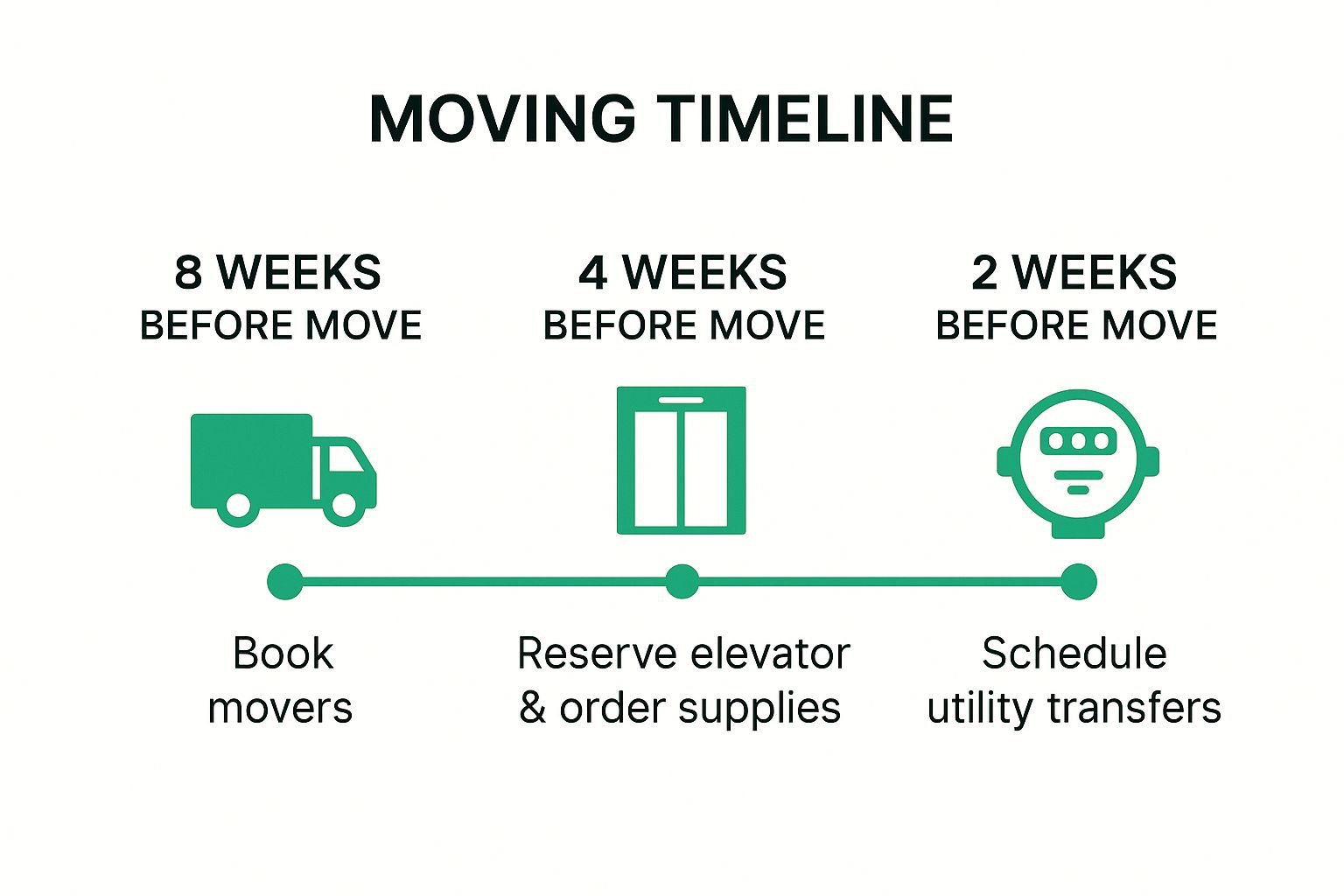Moving into a new apartment marks an exciting new chapter, but the process itself can feel incredibly daunting. Unlike a house move, apartment relocations introduce unique challenges, from navigating tight stairwells and narrow hallways to booking lifts and coordinating with building management. A successful move requires more than just boxes and tape; it demands a strategic approach tailored to the specific constraints of apartment living. Proper planning is the key to avoiding last-minute chaos, protecting your belongings, and ensuring a seamless transition into your new home.
This comprehensive guide is designed to provide you with practical and actionable apartment moving tips to navigate every stage of your relocation with confidence. We'll cover everything from the crucial early planning phases six to eight weeks out, to the specific requirements of your building, and the art of ruthless decluttering. You'll learn how to pack efficiently for a smaller space, handle utility transfers without a hitch, and tackle the logistical hurdles of moving day in a busy urban environment. Forget the stress and overwhelming checklists; this guide offers a clear, step-by-step roadmap. Let's get you moved in, organised, and ready to enjoy your new space from day one.
1. Start Planning 6-8 Weeks Before Moving Day
An apartment move, especially in a dense urban environment, involves navigating a unique set of logistical challenges that a house move often doesn't. From coordinating with building management to reserving lifts and securing parking for the moving truck, the number of external dependencies is significantly higher. Starting your planning process 6 to 8 weeks in advance isn't just a suggestion; it's a strategic necessity that transforms a potentially chaotic experience into a streamlined, manageable project.
This extended timeline allows you to secure the best resources before they become unavailable, particularly during peak moving seasons like summer or the end of the month. Early planning provides the buffer needed to handle paperwork, compare quotes from removalists without pressure, and thoughtfully declutter your space. A well-organised timeline is one of the most effective apartment moving tips for avoiding last-minute stress and unexpected costs.
Key Milestones in Your Moving Timeline
Creating a week-by-week checklist is essential for staying on track. Your timeline should prioritise tasks that rely on external scheduling, such as booking services and coordinating with building managers.
- 8 Weeks Out: This is the time for foundational research and major bookings. Contact removalists for quotes, as popular companies can be booked out months ahead, especially for weekend moves.
- 4 Weeks Out: Focus on logistics and supplies. Contact both your current and new building managers to understand their moving procedures, book the service lift, and inquire about designated parking. This is also the perfect time to start gathering boxes and packing materials.
- 2 Weeks Out: Handle the administrative tasks. Schedule the disconnection and reconnection of your utilities like electricity, gas, and internet. Finalise your change of address with the post office, banks, and any subscription services.
To help you visualise these critical steps, the following timeline highlights the most important booking and scheduling deadlines.

This visual timeline demonstrates how critical early action is, with major service bookings needing to be finalised weeks, and sometimes months, in advance of your move.
2. Research Building-Specific Moving Requirements
Moving into or out of an apartment building is not just about transporting your belongings; it's about navigating a set of rules unique to that specific property. Unlike a standalone house, apartments operate within a shared community, and building management enforces strict policies to ensure moves cause minimal disruption to other residents. Failing to research these requirements is one of the quickest ways to derail your move, potentially leading to fines, denied entry for your removalists, or a stressful last-minute scramble.
Thoroughly understanding these policies is a critical apartment moving tip that prevents logistical nightmares. Many buildings, especially luxury high-rises or managed complexes, have designated moving hours, require elevator reservations, and demand proof of insurance from your removal company. Getting ahead of these requirements ensures your moving day is approved, compliant, and proceeds without any conflicts with building management or your new neighbours.
Key Requirements to Clarify with Building Management
Contacting the building manager or strata committee at both your current and new properties at least four weeks in advance is essential. Request a formal, written copy of their moving procedures to avoid any misunderstandings.
- Moving Hours & Lift Bookings: Many buildings restrict moves to specific times, often weekdays between 9 AM and 5 PM, to minimise noise. You will likely need to book a service lift well in advance, sometimes with a non-refundable deposit.
- Insurance & Paperwork: Your removalist will probably need to provide a Certificate of Currency (proof of public liability insurance) to the building management before they are allowed on the premises. Confirm the required coverage amount, as some high-end buildings in cities like Sydney or Melbourne require policies up to $20 million.
- Access & Parking: Clarify where the moving truck is permitted to park. Is there a designated loading dock with a height restriction? Do you need to reserve a specific parking bay? Understanding access points is crucial for your removalists to plan their route effectively.
Getting these details sorted early allows you to provide your moving company with all the necessary information, ensuring they arrive prepared and fully compliant with building rules. This proactive step is fundamental for a smooth transition into your new apartment.
3. Declutter Ruthlessly Before Packing
Apartment living is often a lesson in space optimisation. Every square metre counts, which makes decluttering before a move one of the most impactful apartment moving tips you can follow. This process involves a systematic evaluation of your belongings to ensure you only transport items that are necessary, valuable, or genuinely loved. It's about more than just tidying up; it's a strategic purge that reduces the volume of goods, which in turn lowers removalist costs, simplifies the packing process, and ensures your new, smaller space feels open and organised from day one.
Embracing this ruthless approach means you avoid paying to move (and then store) items you no longer need. It’s a chance to reassess your lifestyle and possessions, ensuring everything you bring to your new home serves a purpose or brings you joy, a concept popularised by organising consultants like Marie Kondo. For apartment dwellers, this isn't just a helpful tip; it's an essential step to prevent a cluttered and stressful start in a new home.

A Practical Framework for Decluttering
To make the process effective, you need a clear plan of attack. Start at least 4-6 weeks before your move to give yourself ample time without feeling rushed. A structured approach prevents overwhelm and ensures you make thoughtful decisions.
- Categorise and Conquer: Instead of tackling one room at a time, work by category (e.g., all clothes, all books, all kitchen gadgets). This prevents you from simply shuffling items from one room to another and gives you a true sense of how much you own.
- The One-Year Rule: A simple but powerful guideline. If you haven't used an item in the past year and it holds no significant sentimental value, it's a prime candidate for donation, sale, or disposal.
- Measure Everything: Don't assume your current furniture will fit. Measure your large items and compare them against the floor plan of your new apartment. This avoids the costly mistake of moving a sofa that won’t fit through the door or overwhelms the new living room.
To put this into perspective, think of a university student moving after graduation. By selling old textbooks, donating unused furniture, and digitising years of notes, they can significantly reduce their moving load, often fitting everything into their car instead of needing to hire a truck. This proactive sorting is the key to an efficient and cost-effective apartment move.
4. Master the Art of Efficient Apartment Packing
Packing for an apartment move is a science of its own, distinct from packing for a larger house. Limited space during both the packing and unpacking phases means every decision counts. Efficient apartment packing focuses on maximising space within each box, protecting belongings during transit through potentially tight corridors and stairwells, and creating a system that makes settling into your new, often compact, home a seamless process.
This strategic approach is one of the most impactful apartment moving tips because it directly reduces the physical volume of your move. A well-packed studio apartment might only require 30 boxes, whereas inefficient packing could easily double that number, increasing costs and clutter. Smart packing isn't just about putting things in boxes; it's about curating your belongings for a streamlined transition.

Key Strategies for Space-Saving Packing
Adopting a few key techniques can dramatically reduce the number of boxes you need and simplify the entire process. The goal is to make each box as dense and well-organised as possible without making it too heavy to safely lift.
- Weight Distribution is Crucial: The golden rule is to pack heavy items like books, plates, or small appliances in small boxes. This prevents them from becoming dangerously heavy. Lighter, bulkier items such as pillows, linens, and plastic containers should go into larger boxes.
- Use Soft Items as Padding: Save money and space by using what you already own. Wrap fragile items like glasses and vases in your socks, t-shirts, or tea towels instead of bubble wrap. This dual-purpose method protects your breakables while packing your linens simultaneously.
- Create a Detailed Labelling System: Go beyond just writing "Kitchen" on a box. A good label should include the destination room, a summary of contents (e.g., "Pots and Pans"), and a note if it's fragile. For an advanced system, use numbered boxes and keep a corresponding digital list or spreadsheet with a detailed inventory.
- The "First Week" Box is Non-Negotiable: Pack one or two clearly labelled boxes with everything you'll need for the first few days. This includes toiletries, a change of clothes, basic cutlery, medications, device chargers, and essential tools. This prevents a frantic search through dozens of boxes for a toothbrush or phone charger.
For a more in-depth guide, you can explore detailed information on how to pack for movers. This strategic approach ensures that when you arrive at your new apartment, you can unpack logically and with minimal stress.
5. Coordinate Utility Transfers and Address Changes
One of the most overlooked yet critical aspects of an apartment move is the seamless transfer of essential services. Coordinating utility transfers and address changes is a task with many moving parts, where a single missed update can lead to lost mail, billing errors, or arriving at your new apartment without electricity or internet. Unlike a house, where you might be the sole account holder, apartment complexes can have specific procedures or preferred providers, adding another layer to the process.
This administrative effort is a cornerstone of a successful move because it ensures continuity in your daily life. A well-organised approach prevents the stress of being offline when you need to be working remotely or sitting in the dark on your first night. Properly managing these details is one of the most impactful apartment moving tips for a smooth transition, protecting you from service interruptions and potential security risks associated with misdirected sensitive mail.
Key Administrative Tasks for Your Move
A master checklist or spreadsheet is your best tool for tracking every account and service that needs updating. Prioritise these tasks based on their importance and the lead time required for changes to take effect.
- 2-3 Weeks Out: This is the ideal time to schedule your utility transfers. Contact your providers for electricity, gas, and water to arrange disconnection at your old address and connection at your new one. For a comprehensive guide, learn more about the essentials of moving house utilities.
- 1-2 Weeks Out: Focus on communication and financial services. Arrange for mail forwarding with Australia Post. Update your address with your bank, credit card companies, superannuation fund, and the Australian Taxation Office (ATO).
- Moving Week: Confirm your internet installation date aligns with your move-in day, as this is a common source of frustration. On moving day, take final meter readings at your old apartment and snap a photo for your records to avoid any billing disputes.
6. Prepare for Moving Day Logistics
The success of your moving day hinges not just on packed boxes, but on meticulous logistical planning. Unlike moving from a house with a private driveway, an apartment move involves shared spaces and strict building rules that can quickly cause delays if not handled in advance. Preparing for these logistical challenges, from securing parking for the removalist truck to ensuring clear communication channels are open, is a critical step that prevents on-the-day chaos and ensures a smooth, efficient transition into your new home.
This level of preparation is what separates a stressful move from a streamlined one. By anticipating potential hurdles like unavailable lifts, difficult street parking, or restricted access times, you can create contingency plans and communicate effectively with your moving company. Thinking through these details demonstrates proactive management of your move, saving time, money, and frustration for everyone involved on the day.
Key Logistical Tasks for a Smooth Move
Your focus should be on eliminating any potential bottlenecks before the removalists arrive. This involves confirming arrangements you made weeks prior and preparing for the immediate needs of moving day.
- Confirm Building Access: A day or two before the move, reconfirm your lift booking and any specific access instructions with both your current and new building managers. Ensure you know who to contact if an issue arises on the day.
- Secure Parking: If you’ve arranged parking permits, ensure they are clearly displayed. If no permits are required, scout the area and block off a suitable space for the truck with your own vehicle or cones, if permitted.
- Prepare Your Old Apartment: Part of your logistical planning involves leaving your old apartment in excellent condition. To ensure you get your full security deposit back, it's wise to consult a comprehensive guide to end of lease cleaning for a step-by-step checklist.
- Pack a 'Day One' Box: Keep a clearly labelled box or bag with you containing essentials you'll need immediately upon arrival. This should include phone chargers, toiletries, medications, snacks, water, a first-aid kit, and important documents.
- Arrange Cash for Tips: While not always expected, having some cash on hand for tipping your removalists is a nice gesture for a job well done. It also covers any unforeseen minor expenses.
7. Navigate Urban Moving Challenges
Moving into an urban apartment involves more than just packing boxes; it requires navigating a complex environment of limited parking, traffic congestion, narrow staircases, and strict building regulations. A successful city move hinges on proactively identifying and planning for these obstacles. Whether it's a Brooklyn brownstone with tight turns or a San Francisco high-rise on a steep hill, urban logistics demand a specialised approach that anticipates problems before they arise.
These unique environmental factors are why urban moves often require more detailed preparation than a suburban house move. A failure to plan for a lack of loading zone space or a narrow doorway can lead to significant delays, extra costs, and immense stress on moving day. By addressing these challenges head-on, you ensure a smoother transition and protect your belongings from damage. These practical apartment moving tips are essential for a hassle-free urban relocation.
Key Strategies for Urban Environments
A site visit to both your old and new properties is non-negotiable. This reconnaissance mission allows you to measure access points and identify potential bottlenecks, providing critical information for your removalists.
- Measure Everything: Before moving day, measure all doorways, hallways, stairwells, and lift dimensions. Compare these measurements against your largest pieces of furniture, like sofas and bed frames, to confirm they will fit.
- Research Local Restrictions: Investigate local council regulations regarding parking permits for moving trucks, loading zone time limits, and potential traffic restrictions. In cities like Perth, understanding these rules is crucial for a smooth move. Learn more about best practices for navigating Perth moving successfully to avoid fines and delays.
- Plan Your Timing: Schedule your move for off-peak hours, such as early on a weekday morning, to avoid the worst of the city traffic. Also, check with building management for any blackout dates or times due to other scheduled activities like construction or events.
8. Execute Strategic Unpacking and Setup
The physical move might be over, but the final, crucial phase is transforming a space full of boxes into a functional home. Strategic unpacking is not just about emptying containers; it's a deliberate process of prioritising rooms, setting up essential systems, and optimising your new, often limited, apartment layout from the very beginning. This methodical approach combats the overwhelming feeling of being surrounded by clutter and helps establish a sense of order and comfort quickly.
Adopting a systematic unpacking plan is one of the most effective apartment moving tips for settling in efficiently. Instead of randomly opening boxes, you focus your energy on high-impact areas first, allowing you to resume normal life routines, like cooking a meal or having a comfortable night's sleep, as soon as possible. This prevents unpacking fatigue and ensures your new apartment becomes a liveable, organised sanctuary rather than a chaotic storage unit.
Key Milestones for Unpacking Your Apartment
Creating a clear order of operations is essential for an efficient setup. Your plan should prioritise establishing basic comforts and functional living zones before tackling less critical areas.
- First 24 Hours: Focus on immediate needs. Set up your bed with fresh linens and unpack toiletries for the bathroom. In the kitchen, unpack the "essentials" box containing a coffee maker, a pan, basic utensils, and cleaning supplies. This allows you to rest, refresh, and prepare simple meals without relying on expensive takeaway.
- First 48 Hours: Establish a primary living zone. If you work from home, setting up a functional desk space is a priority. For families, this might mean organising the children's bedrooms to provide them with a sense of stability. The goal is to make one or two rooms completely liveable.
- First Week: Tackle the remaining rooms one by one. Fully unpack, organise, and decorate one room completely before moving on to the next. This provides a sense of accomplishment and prevents the chaos of half-finished rooms spreading throughout the apartment. Install any new storage solutions, like shelving or wardrobe organisers, before you start placing items.
8 Key Apartment Moving Tips Comparison
| Strategy | Implementation Complexity 🔄 | Resource Requirements ⚡ | Expected Outcomes 📊 | Ideal Use Cases 💡 | Key Advantages ⭐ |
|---|---|---|---|---|---|
| Start Planning 6-8 Weeks Before Moving Day | Moderate to High: Requires upfront significant time | Moderate: Time investment, communication efforts | Smooth transition, reduced stress, better rates, issue mitigation | Moves in busy urban areas with strict scheduling, corporate relocations | Early booking savings, stress reduction, better coordination |
| Research Building-Specific Moving Requirements | Moderate: Involves detailed policy review and coordination | Low to Moderate: Mainly communication and documentation | Avoids fines/delays, ensures smooth building access | Moves to buildings with strict policies or deposits | Prevents costly penalties, secures elevator use and access |
| Declutter Ruthlessly Before Packing | Moderate to High: Systematic sorting and decision-making | Low to Moderate: Time and effort for sorting | Cost reduction, faster packing/unpacking, fresh start | Downsizing, limited space apartments, budget-conscious movers | Reduced moving costs, less volume, potential income from sales |
| Master the Art of Efficient Apartment Packing | High: Detailed packing strategy and inventory tracking | High: Supplies, time, physical effort | Maximized space use, item protection, efficient unpacking | Small apartments, moves requiring careful handling of fragile goods | Cost and time savings, protection of belongings, reduced trips |
| Coordinate Utility Transfers and Address Changes | Moderate: Multi-provider coordination required | Low to Moderate: Time for calls and scheduling | Uninterrupted services, no billing issues, continuous connectivity | Moves involving multiple service providers | Avoids service gaps, reconnection fees, and missed mail |
| Prepare for Moving Day Logistics | High: Extensive coordination across parties | Moderate: Time and effort for communication and permits | Reduced moving day stress, minimized delays and fees | Urban moves requiring permits and precise timing | Smooth logistics, minimized surprises and complications |
| Navigate Urban Moving Challenges | High: Specialized planning and equipment needed | High: Equipment, time for site visits and planning | Successful move despite obstacles, property safety, legal compliance | Moves in dense urban environments with access constraints | Avoids damage/fines, maintains community relations |
| Execute Strategic Unpacking and Setup | Moderate: Sustained energy and organizational effort | Moderate: Time, possible purchase of storage solutions | Functional living space quickly, reduced chaos, routine establishment | All apartment moves seeking efficient settling in | Faster comfort, space maximization, lowered post-move stress |
Make Your Next Move Your Best Move
Moving apartments doesn't have to be the chaotic, stressful ordeal it's often made out to be. As we've explored, the secret to a smooth transition lies in a well-structured approach that begins long before the first box is even packed. By transforming this complex project into a series of manageable tasks, you can maintain control and minimise last-minute panic.
The journey from your old apartment to your new one is paved with careful preparation. From the initial 6-8 week planning phase to the final box being unpacked, each step builds upon the last. Embracing these apartment moving tips is about more than just efficiency; it's about setting the stage for a positive start in your new home. A successful move allows you to focus on the excitement of a new beginning, rather than the stress of a disorganised relocation.
Key Pillars of a Successful Apartment Move
Let's recap the foundational principles that will make your next move your best one yet:
- Proactive Planning is Paramount: The most crucial takeaway is the power of starting early. Researching your building's specific moving requirements, coordinating utility transfers, and creating a detailed timeline are non-negotiable steps that prevent major headaches on moving day.
- Work Smarter, Not Harder: Ruthless decluttering isn't just about getting rid of things; it's a strategic move to reduce packing time, lower removalist costs, and start fresh. Similarly, a methodical packing and labelling system is what separates a seamless unpacking process from weeks of frustrating searching.
- Anticipate the Unique Challenges: Apartment moves come with their own set of obstacles, from navigating tight corridors and lifts to securing parking for a moving truck in a busy urban area. Acknowledging these potential issues in advance allows you to formulate a plan and avoid costly delays.
Ultimately, the goal is to orchestrate a move that feels organised, controlled, and even empowering. By implementing these strategies, you are not just moving your belongings; you are carefully curating the first chapter in your new space. You're taking an event that is infamous for its stress and turning it into a well-executed project, giving you the peace of mind to truly enjoy your new home from the moment you step through the door.
Ready to put these apartment moving tips into action with professional support? For a seamless and stress-free move in the Perth area, contact the experts at Emmanuel Transport. Their experienced team specialises in navigating the unique challenges of apartment relocations, ensuring your belongings are handled with the utmost care. Visit Emmanuel Transport to get a quote and make your next move the easiest one yet.













